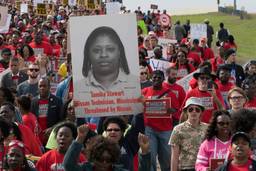The grim news that labor union membership dropped again last year reflects the declining power of the labor movement, its fragility exacerbated by the great recession. And that weakness undermines progressive political influence, thus making it harder to change public policy to strengthen workers’ rights and freedom of association.
Here are the latest numbers on this downward spiral: The Bureau of Labor Statistics reports that union membership dropped last year by about 600,000, reducing the share of wage and salary workers who are union members from 12.3 percent to 11.9 percent. More than half of union members are public employees, whose unionization rate slipped slightly to 36.2 percent. Only 6.9 percent of private-sector workers now belong to unions, down from 7.2 percent.
Although figures collected before and after 1983 are not precisely comparable, union membership had not been below 13 percent of the total labor force since 1936, as the big union organizing explosion of the New Deal era ignited. With unemployment remaining high and ascendant right-wing Republicans — joined by far too many Democrats — now attacking organized labor’s main strongholds among public employees, the prospects are not bright for 2011 either.
But while workers and unions will not be able to count on much of the political help they need in the near-term, except for some incremental improvements from the National Labor Relations Board, they can still use their remaining power to disrupt business as usual. And they can strengthen their alliances with such constituencies as environmentalists, immigrant rights advocates, and the religious community. That’s needed for both immediate defense as well as laying the groundwork for larger-scale organizing, like what the United Auto Workers (UAW) union recently announced for foreign-owned auto plants.
Disproportionately high layoffs in construction, an industry about twice as densely unionized as the private sector in general, eroded union membership, as Center for Economic and Policy Research associate Ben Zipperer noted.
But since 2007, a higher percentage of union workers than non-union have lost jobs in construction and manufacturing, as Daniel Indiviglio observes in The Atlantic. That suggests that employers may be targeting unionized sections of their operations for layoffs or closings, or that nonunion firms have had a competitive advantage. With union membership so low, nonunion businesses increasingly set the terms for labor markets, not those that are unionized as in the heyday of the UAW.
Low unionization contributes to high unemployment
Indeed, it’s lack of union power that contributes to the higher unemployment rate in the United States compared to Europe and Japan (while at the same time, U.S. gross domestic product dropped less and corporate profits have been relatively unscathed), as David Leonhardt, Paul Krugman, Ezra Klein, and others argue.
Also, as an outgrowth of union weakness, labor market regulations in the U.S. provide less protection against layoffs compared to other rich countries, indirectly contributing to erosion of union membership. Late last year, Democrats barely won extension of unemployment benefits in a distasteful tax deal with Republicans, while workers in rich countries with stronger labor movements provided more protection from layoffs.
(For example, a new study from the Organization for Economic Cooperation and Development concludes that “short-time work” arrangements
had an “economically important impact on preserving jobs during the downturn”, with the largest impacts in Germany and Japan of the 16 countries analysed. In Germany, 235,000 jobs were saved and in Japan 415,000, equivalent to 0.8% and 0.9% of employees respectively.
Short-time work schemes spread reduced work hours among workers, avoiding layoffs and unemployment when business slumps, but pay workers amounts varying up to as much as their regular, full-time wages, in place of more meager unemployment compensation.)
In 2007 and 2008 the union share of employed workers rose slightly after decades of decline, but hopes that organizing would accelerate and maintain that growth have been dampened. With the economic downturn, as well as harsh, often inaccurate blame directed at unions for GM and Chrysler’s bankruptcy and for state and city budget crises, public approval of unions dropped sharply. Workers’ job security fears grew as well, together making organizing more difficult.
It’s hard to tell how much organizing activity is occurring because so much recruiting of new members takes place outside traditional NLRB-supervised elections. The NLRB figures themselves, however, are not greatly encouraging. Unions now win a higher percentage of elections — 66 percent last year, but the number of elections dropped from 2,645 in 2001 to 1,571 last year, an uptick from the record low of 1,335 in 2009.
Only about half as many petitions for elections were filed (2,380 in 2010 compared to 4,145 in 2001), but that’s partly because unions seem to be more cautious about filing and end up withdrawing fewer election petitions, typically after management anti-union tactics undermined union support. But even with more union-favorable rules in place under the National Mediation Board (the counterpart of the NLRB for rail and air industries), unions had mixed fortunes at best organizing airline workers last year.
The new UAW drive, based on an offer to cooperate with the companies to make them successful, reflects the union’s present weakness, but also represents a common strategy among unions to try to set up rules for organizing campaigns that neutralize management’s anti-union tactics.
Such a plea for civility risks rejection by companies that now have the upper hand. But there’s a risk as well that a union will concede too much of its power and rights of workers to gain more neutrality. UAW president Bob King hopes to make union organizing a recognized human right, tagging recalcitrant employers as human rights violators.
It’s a gamble whether the strategy will work as King describes it. But only if more unions take such big gambles and vigorously force the issue of worker rights into public debate will the unionized share of the workforce and the prospects for progressive politics head upward together.
David Moberg, a former senior editor of In These Times, was on staff with the magazine from when it began publishing in 1976 until his passing in July 2022. Before joining In These Times, he completed his work for a Ph.D. in anthropology at the University of Chicago and worked for Newsweek. He received fellowships from the John D. and Catherine T. MacArthur Foundation and the Nation Institute for research on the new global economy.








